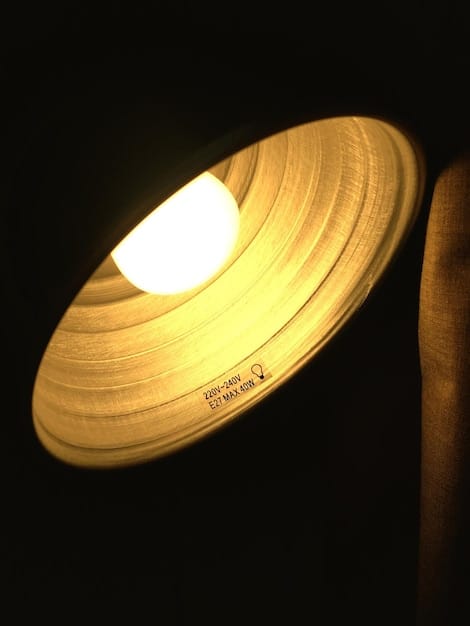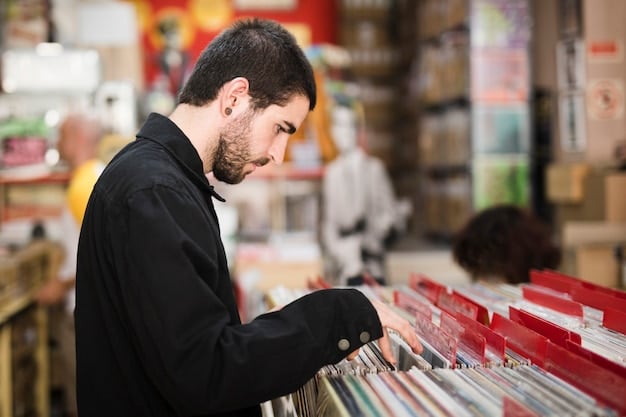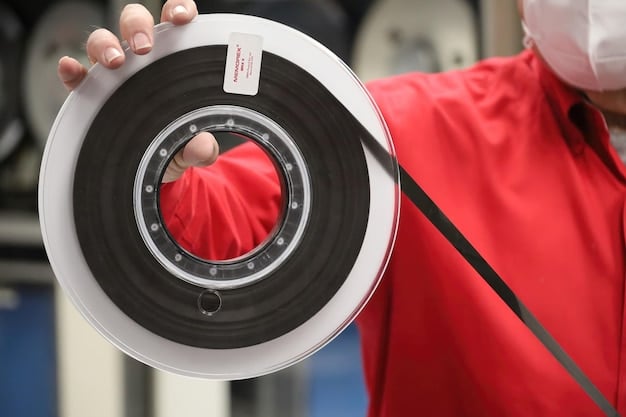Vinyl Records Surge: New Study Shows 30% of Rock Fans Prefer the Format

A recent study indicates that 30% of rock fans prefer vinyl records, suggesting a possible resurgence of the format driven by its unique sound and tactile experience despite the dominance of digital music.
Is vinyl making a comeback? A new study reveals 30% of rock fans prefer vinyl records, sparking debate about whether this classic format is experiencing a genuine resurgence in the digital age.
The Vinyl Renaissance: A New Study’s Findings
The appeal of vinyl records has endured, even as digital music dominates the industry. Examining the preference of rock fans for this format, a recent study provides insightful data on the vinyl renaissance and its place in modern music consumption.
This section delves into the key findings of the study, shedding light on the dynamics of this resurgence and what it means for the future of music.
Key Findings of the Study
The study surveyed rock fans on their preferred music formats. Let’s look at some of the key results that emerged from this survey:
- 30% Preference for Vinyl: This demonstrates a substantial minority actively choosing vinyl over other formats.
- Superior Sound Quality: Many respondents cited the warmer, more authentic sound of vinyl as a primary reason.
- Tangible Experience: The physical act of handling a record, reading the liner notes, and appreciating the artwork was valued.
- Nostalgia Factor: Some fans mentioned childhood memories associated with vinyl as a driver of their preference.
These findings suggest that the vinyl resurgence is driven by a combination of factors, including sound quality, the tangible experience, and nostalgia.
In conclusion, the study underscores that vinyl has found its niche among rock fans, suggesting its unique characteristics fuel a dedicated comeback.

Why Rock Fans Are Choosing Vinyl
What is it about vinyl records that appeals to rock fans? Despite the convenience of digital music, many still prefer the tactile experience and unique sound that vinyl offers. Let’s investigate the allure that draws rock fans back to this physical format.
This section explores the reasons why rock fans are increasingly choosing vinyl over other formats, providing insights into the motivations behind this preference.
Several factors contribute to the appeal of vinyl among rock fans:
- Analog Warmth: Vinyl records produce a unique analog sound that is often described as fuller and warmer than digital recordings. This is a key differentiator.
- Physical Engagement: Rock fans appreciate the ritual of selecting a record, placing it on the turntable, and carefully dropping the needle.
- Artwork and Liner Notes: Album artwork and liner notes offer a visual and informative experience, contributing to the overall appreciation.
- Collectibility: Many rock fans enjoy collecting vinyl records, building curated collections that are both personal and valuable.
The tangible nature of vinyl, combined with the unique sound characteristics, contributes to its enduring appeal among rock fans.
Overall, the preference for vinyl by rock fans stems from more than just sound; it’s a multifaceted experience of collecting, listening, and connecting with music.
The Impact of Vinyl on the Music Industry
What kind of changes are occurring in the music industry, thanks to the renewed interest in vinyl records? The vinyl resurgence has had a noticeable impact on several aspects of the music industry, from production to distribution. Let’s examine the implications.
This section examines how the resurgence of vinyl is impacting the music industry, from independent record stores to major labels.
Here are some key areas where vinyl is impacting the music industry:
- Resurgence of Record Stores: The vinyl comeback has fueled a revival of independent record stores, providing a physical space for music enthusiasts.
- Increased Vinyl Production: Record pressing plants are seeing increased demand, leading to expansions and new facilities.
- Support for Artists: Vinyl sales offer a direct revenue stream for artists, particularly those who release limited edition pressings.
- Marketing and Branding: Vinyl releases are used as a marketing tool, appealing to collectors and fans seeking a premium product.
The increasing demand for vinyl is creating opportunities for record stores, pressing plants, and artists, demonstrating a renewed consumer interest in physical formats.
In short, the impact of vinyl resurgence includes a more diversified landscape, benefiting local record stores and providing alternative revenue streams for artists.

Digital vs. Vinyl: The Enduring Debate
The battle between digital music and vinyl continues. Each format has its advantages and disadvantages, leading to an ongoing debate among music enthusiasts. What does this mean for rock fans, and those who prefer listening to the analog warmth of vinyl records?
This section dives deeper into the debate between digital music and vinyl, exploring the pros and cons of each format and highlighting the key differences.
Advantages and Disadvantages
The debate between digital and vinyl lies in contrasting their properties and usage. Here’s a breakdown of the key advantages and disadvantages of each format:
Digital Music
- Convenience and Portability
- Vast Selection of Music
- Accessibility
- Sound Quality Limitations (Compressed Audio)
Vinyl Records
- Analog Warmth and Authenticity
- Tangible Experience
- Collectibility and Investment
- Limited Availability
The choice between digital and vinyl often comes down to personal preference, balancing convenience with the unique qualities of analog sound.
To summarise, whether digital or vinyl reigns supreme depends on the listener’s priorities, preferences, and values.
The study reinforces that for rock fans, the preference for vinyl records goes beyond sound, encompassing a multi-sensory experience.
How to Start Your Vinyl Collection
Thinking of starting a vinyl record collection? Starting a vinyl collection can be a rewarding experience, offering a tangible connection to your favorite music. This part goes through the best ways to initiate and nurture your assortment of records, focusing on rock music in particular.
This section provides a practical guide for those looking to start their own vinyl collection, offering tips and advice for beginners.
Key Elements of Building a Vinyl Collection
Starting a vinyl collection involves more than just buying records. Here are some essential steps to follow:
- Invest in a Turntable: Select a quality turntable that suits your budget and provides good sound.
- Explore Local Record Stores: Visit local record stores to discover new and used records.
- Learn to Care for Records: Properly clean and store your records to maintain their condition.
- Curate Your Collection: Focus on albums that you love and want to listen to regularly.
Starting a vinyl collection requires both an investment and a dedication to caring for the records, but it can lead to great enjoyment.
Building a curated vinyl collection enhances your listening enjoyment, connecting you deeply with the music you appreciate.
The Future of Vinyl Records
Where does the future point for vinyl records? While digital formats continue to dominate the music industry, vinyl’s current resurgence suggests it has a place in the future. What kind of path will vinyl take towards the future of rock music and beyond?
This final section looks ahead to the future of vinyl records, examining the current trends and what they might mean for the format’s long-term viability.
The future of vinyl records is uncertain, but current trends suggest the following:
- Niche Format: Vinyl will likely remain a niche format, appealing to collectors, audiophiles, and those seeking a tangible experience.
- Collaborations and Special Editions: Artists will continue to release limited edition vinyl pressings and collaborations.
- Technological Advancements: New technologies may emerge to improve the pressing and playback quality of vinyl.
The future of vinyl records is likely as a niche format, prized for its unique qualities and tangible impact, as the study reinforces.
Eventually, vinyl’s lasting presence hinges on its singular qualities and its dedicated community supporting its future for fans of rock and beyond.
| Key Point | Brief Description |
|---|---|
| 🎵 Vinyl Preference | 30% of rock fans prefer vinyl, highlighting its unique appeal. |
| 🎧 Superior Sound | Many fans claim vinyl provides a warmer, more authentic sound experience. |
| 💿 Tangible Experience | Handling the record and reading liner notes enriches the listening. |
| 🚀 Industry Impact | Vinyl’s comeback boosts record stores and supports artists with sales. |
Frequently Asked Questions
▼
Vinyl records are making a comeback due to their unique audio quality, tangible experience, and the nostalgia they evoke. Many listeners find the ‘analog warmth’ of vinyl more pleasing than digital recordings.
▼
Yes, many new albums are released on vinyl! Artists and record labels recognize the demand for physical media, and often offer vinyl versions alongside digital downloads and streaming options to cater to a wider audience.
▼
To care for vinyl records, store them upright in their sleeves, handle them by the edges, and avoid touching the playing surface. Clean them regularly with a carbon fiber brush and consider using a record cleaning solution.
▼
Many audiophiles believe vinyl sound quality is superior due to the analog nature of the recordings, which can capture a broader range of frequencies and create a warmer, more detailed sound compared to compressed digital formats.
▼
The future of vinyl records looks promising as a niche format embraced by collectors and music enthusiasts. Its revival indicates a lasting appreciation for physical media in the digital age, with continued special editions and releases.
Conclusion
The recent study highlighting the preference for vinyl records among 30% of rock fans underscores a broader resurgence of this format. Driven by its unique sound and tactile experience, the vinyl comeback reflects a desire for a more personal and immersive relationship with music, suggesting its place in the industry.





